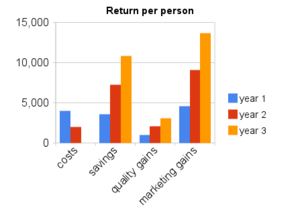The business case for social media in the workplace and the inevitable ROI conversation have polarized innovation advocates and doubters for years. There’s a saying in marketing that we always waste half of our marketing budget, we just don’t know which half. The fact that we are still witnessing the infancy of social technologies leads us to this situation where the ground we’re standing on keeps moving and changing all the time, and very few have been able to establish a clear, irrefutable correlation between the adoption of social media and sustained business results. Does this mean that the quest to find the elusive perfect ROI model should just be abandoned by all of us? My answer is yes, but not for the reasons you may be thinking.

Malcolm Gladwell, in his hilarious TED talk on spaghetti sauce a few years ago, told the story of Howard Moskowitz’s epiphany while looking for the perfect concentration of aspartame to use in the Diet Pepsi formulation:
Howard does the experiment, and he gets the data back, and he plots it on a curve, and all of a sudden he realizes it’s not a nice bell curve. In fact, the data doesn’t make any sense. It’s a mess. It’s all over the place. (…) Why could we not make sense of this experiment with Diet Pepsi? And one day, he was sitting in a diner in White Plains (…). And suddenly, like a bolt of lightning, the answer came to him. And that is, that when they analyzed the Diet Pepsi data, they were asking the wrong question. They were looking for the perfect Pepsi, and they should have been looking for the perfect Pepsis.”
Over the last few years, many in the social media space have been on a quest to find the perfect ROI model for blogs, micro-blogs, wikis, social networking, social bookmarking and other animals in the ever growing Social Business zoo. You’ll see opinions ranging from “We don’t need ROI for social media” to “Social media has to rely on a lagging ROI” to “Social media ROI comes from time savings.” In a way, they are all right and all wrong at the same time. Paraphrasing Doctor Moskowitz, there is no perfect social media ROI model, there are only perfect social media ROI models.
Over the years, I’ve been discussing the business value of social media with both believers and skeptics, and have noticed a wide range of approaches when deciding whether or not (and how much) to invest in social computing. For companies in the forefront of the social media battleground, such as newspapers, book publishers, and TV channels, investing heavily in new Web technologies has often been a question of survival, and decision makers had significant leeway in trying new ways of delivering their products and services, with the full blessing of their stakeholders. On the other side of the spectrum, in sectors such as financial services, social media is not yet unanimously regarded as the way to go. I’ve heard from a number of people working in banking and insurance that, if social media advocates don’t clearly articulate the returns they are expecting, they won’t get the funds to realize their vision. However, to balance things out, in most of the other industries, investments in innovation are being subject to even more scrutiny than normal due to the tough current economic environment. So, having a few ROI models in your pocket does not hurt.
The following ROI models are emerging, and we can expect a few more to appear in the near future.
1. Lagging ROI. Some time ago, I spoke to the CIO of a global retail chain, who had an interesting approach towards strategic investments in emerging technologies. Instead of trying to develop a standard business case based on pie-in-the-sky ROI calculations, he managed to convince the board of directors to give him more flexibility to invest in a few projects his team deemed to be essential for the long-term survival of the company. For those, he would provide after-the-fact ROI metrics, so that decision makers could assess whether to keep investing or pull the plug. He also managed expectations by saying up front that some of those projects would fail, but doing nothing was not an option. By setting aside an innovation bucket and establishing a portfolio of parallel innovation initiatives, you can hedge your bets and improve your overall success rate.
2. Efficiency gains or cost avoidance. Many of the early social media ROI models were based on how much time you save by relying on social media, converting that to monetary terms based on the cost of labor. While this is certainly a valid approach, it needs to be supplemented by other sources of business value. Unless you are capable of mapping the saved minutes with other measurable outcomes derived from having more time available, the most obvious way to realize the value of being more efficient is to reduce head count, as in theory the group can do the same work as before with fewer people. If that’s the core of your business case justification, it may backfire in the long term, as some people might feel that the more they use social computing, the more likely it is that their department will be downsized.
3. Proxy Metrics. Some of the ROI examples in the Groundswell book and blog rely on proxy marketing metrics–i.e., what would be the corresponding cost of a conventional marketing campaign to achieve the same level of reach or awareness. For example, when calculating the ROI of an executive blog, the authors measure value by calculating the cost of advertising, PR, SEO, and word-of-mouth equivalents.
4. Product/Service/Process Innovation. The value of customer or employee insights that end up generating brand new products, services, and processes, or improvements to existing ones needs to be taken into account. Measuring the number of new features is relatively straightforward. Over time, you may want to figure out the equivalent R&D cost to get the same results.
5. Improved Conversions. Back to the Groundswell book, one of its ROI examples shows how ratings and reviews can improve conversion rates (i.e., from all people visiting your site, how many more buy products because they trust the input from other consumers, compared to typical conversion rates).
6. Digitization of knowledge. By having employees blogging, contributing to wikis, commenting or rating content, creating videos and podcasts, companies are essentially enabling the digitalization of knowledge. Things that used to exist only in people’s heads are now being converted to text, audio and images that are searchable and discoverable. It’s the realization of the asset that Clay Shirky calls the cognitive surplus. That was an elusive resource that didn’t have much monetary value before the surge in user-generated content. Naturally, a fair portion of that digitalized knowledge has very little business value, so you need to find metrics to determine how much of that truckload of content is actually useful. You can infer that by using cross-links, comments, ratings or even number of visits.
7. Social capital and empowerment of the workforce. There is certainly business value in having a workforce composed of well connected, well informed and motivated employees. What metrics can be used to assess the degree of connectivity/knowledge/motivation of your human resources? Several social computing tools now give you indirect metrics that provide a glimpse of items you may want to monitor, such as how one’s network reach evolves over time.
As you can see in several of the emerging models listed above, there are often three types of inputs to develop ROI calculations:
- Quantitative metrics that can be obtained directly from the system data and log files
- Qualitative metrics that are determined using surveys, questionnaires, and polls
- Dollar multipliers that attribute arbitrary monetary value to hard to assess items such as a blog comment or an extra contact in your social network
For the monetary value, I would suggest to adopt a sensitivity analysis approach, working with conservative, average, and aggressive scenarios, and adjusting them over time. Just don’t go overboard: there’s an ROI for calculating ROI. ROI models should be easy to understand, as decision makers will often frown upon obscure calculations that require a PhD in financial modeling.
In summary: we don’t need one social media ROI model, we need many of them. None of the ones emerging now is perfect, and none will ever be. You might need to have a few in your toolkit and develop a sense of when to use each one.
Originally published on The Bamboo Raft.





